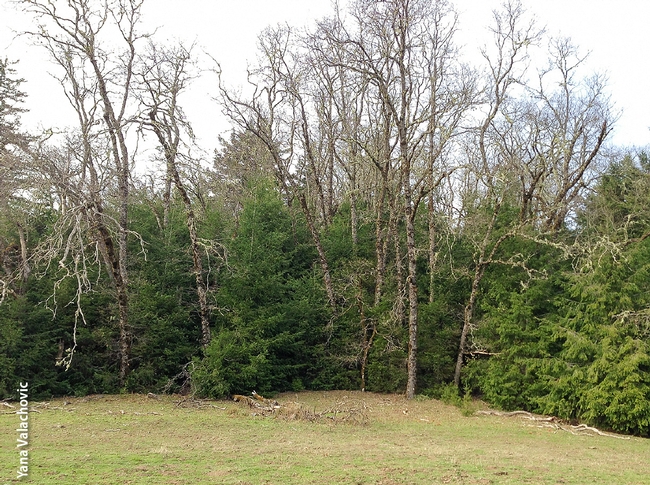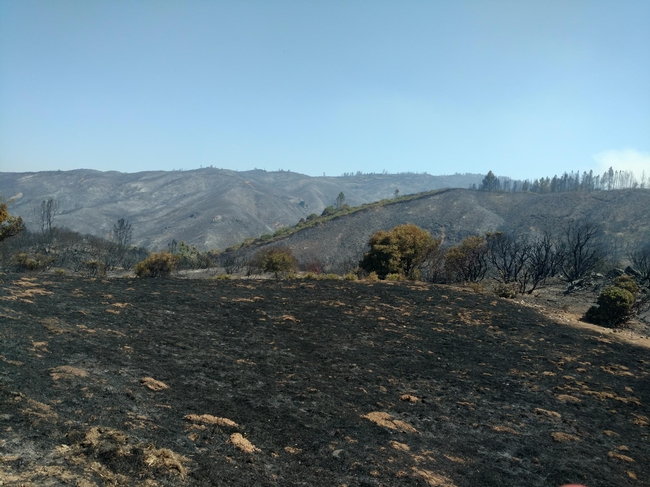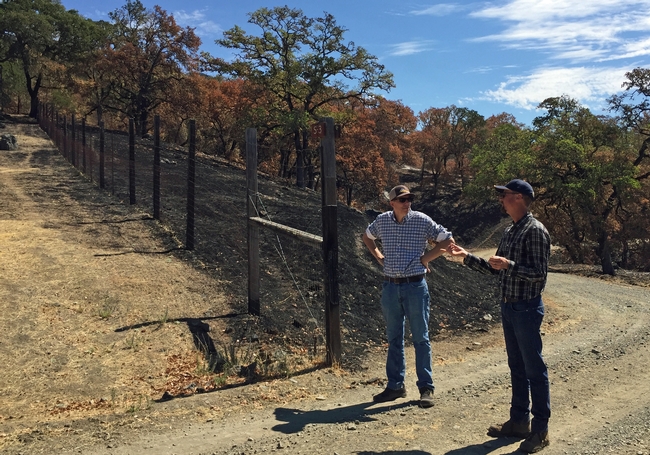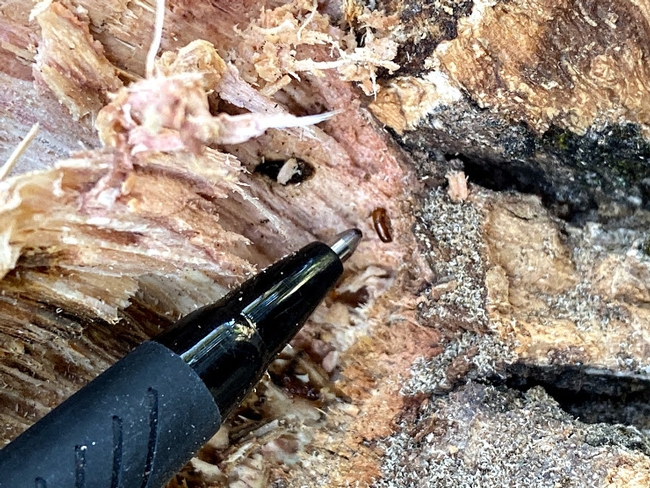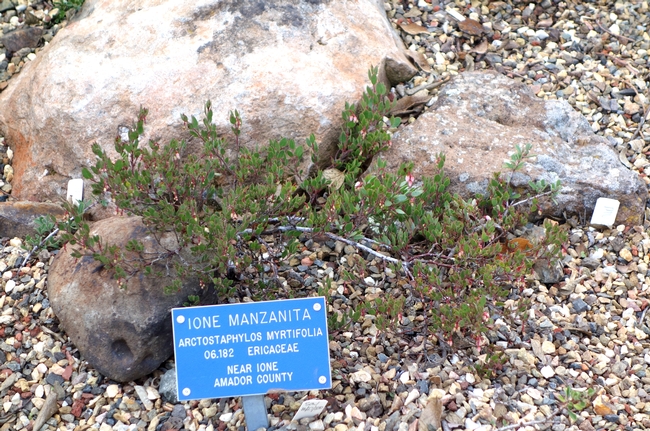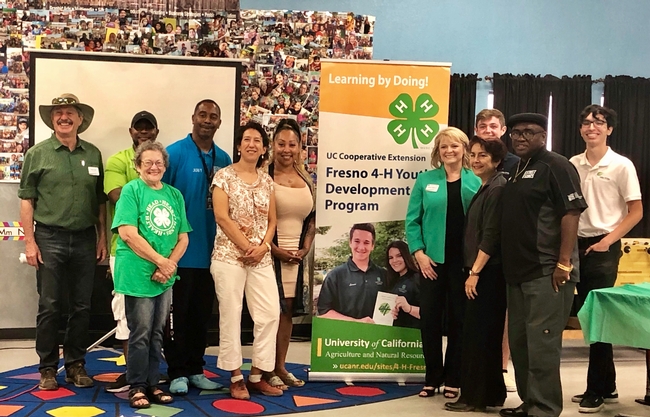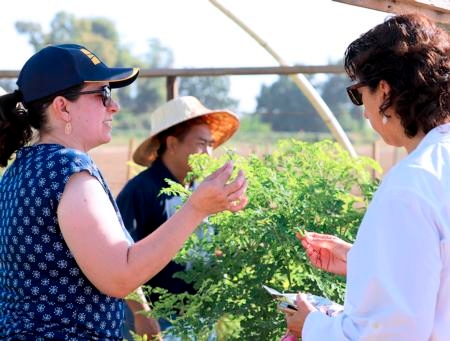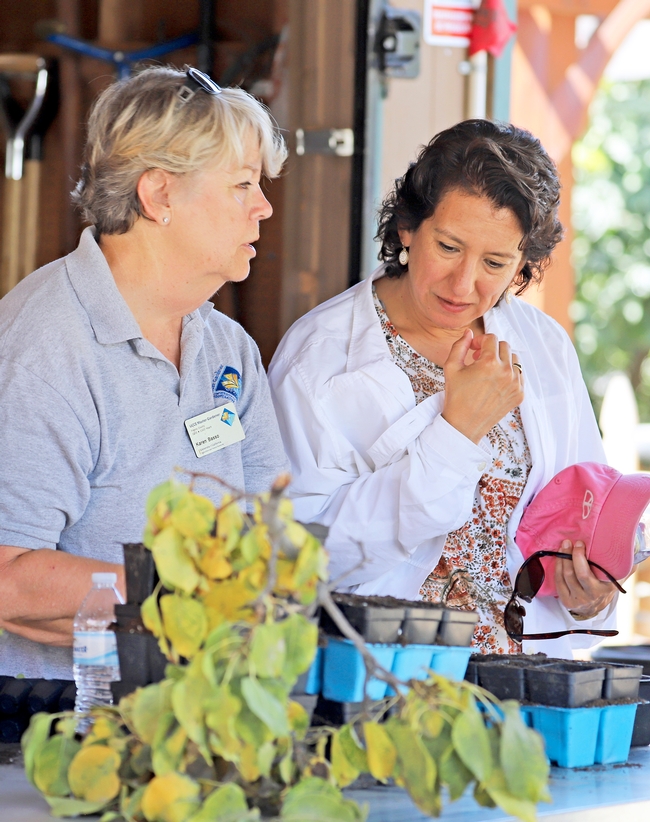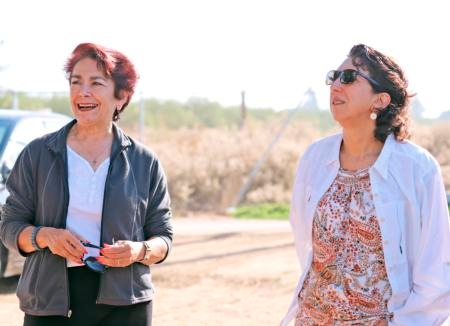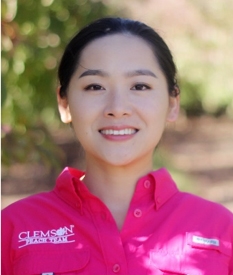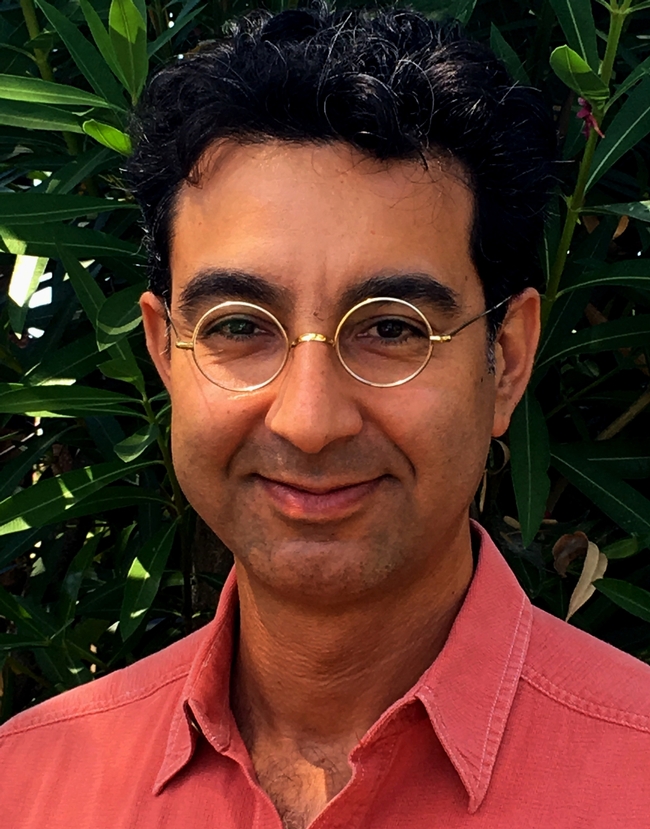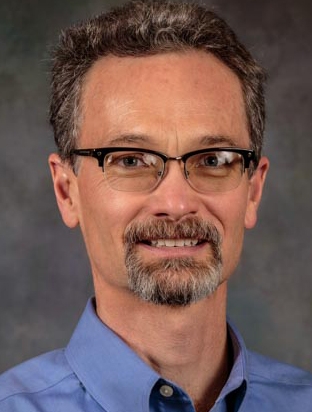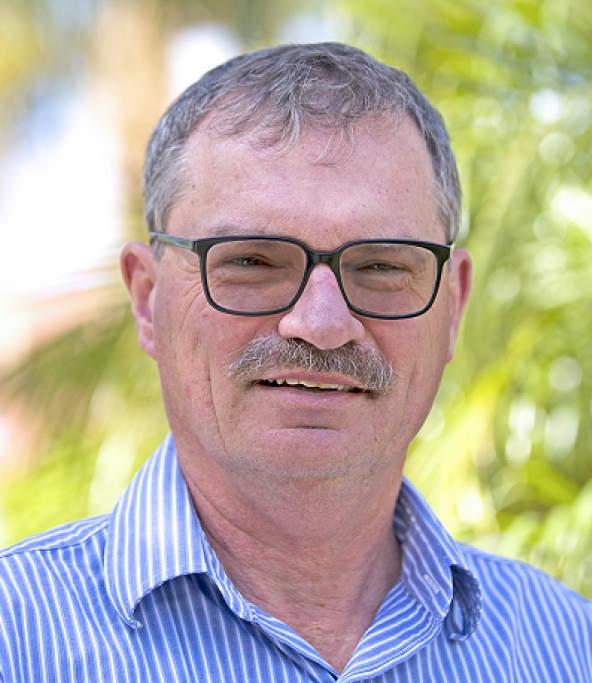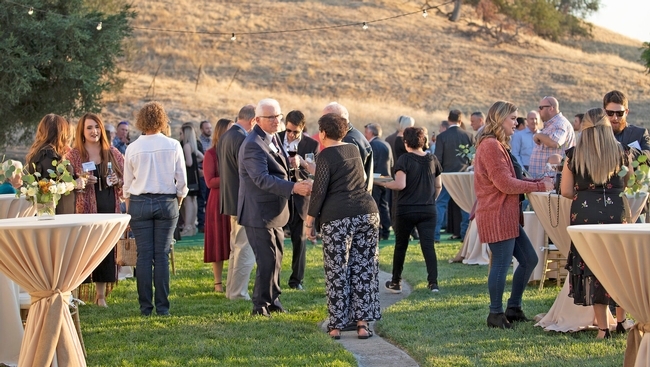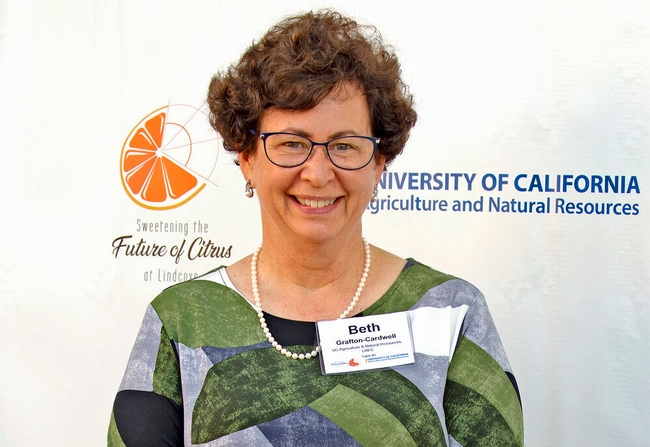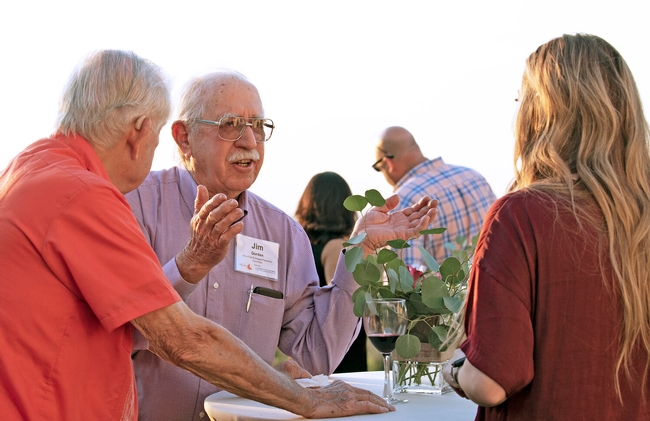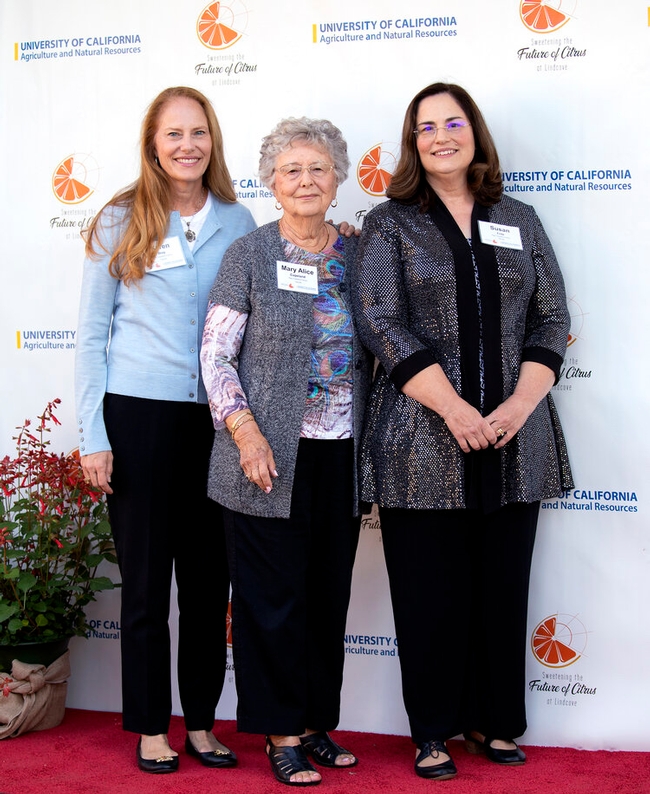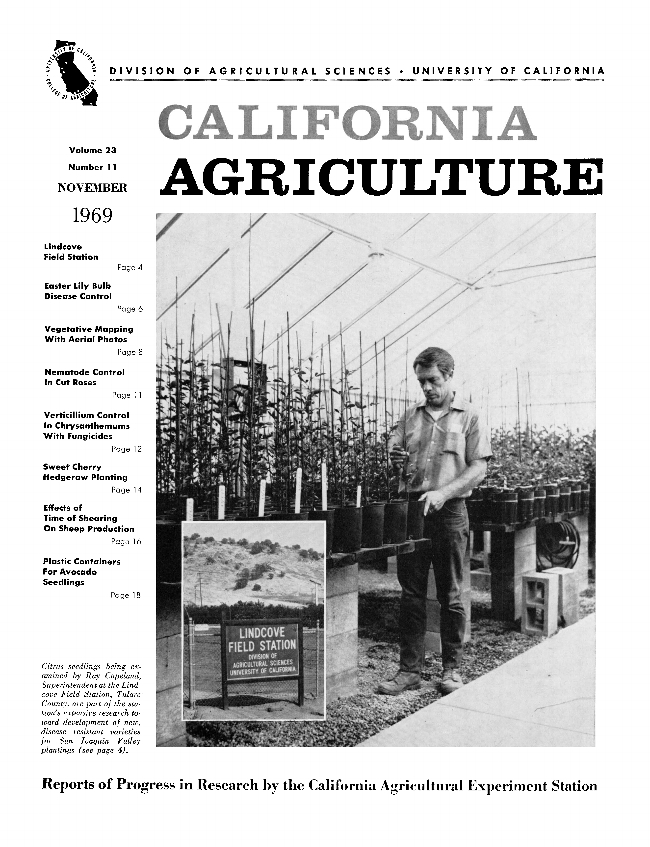Posts Tagged: Oak Woodlands
Hundreds sign up for online oak woodland workshop
California oak woodlands are highly prized ecoregions where stately trees, many of them hundreds of years old, are cornerstones of a habitat for wildlife and native plants. Sadly, some of these ecosystems are seriously threatened by exotic pests and diseases, encroachment by less desirable vegetation, and wildfire.
Each year, UC Cooperative Extension hosts workshops to share scientific developments aimed at conserving these important habitats – and the economic value of ranching – on oak woodlands, which are found on the lower elevation slopes of the Sierra Nevada, the Coast Range and other foothill areas of California.
Typically, the workshops are held in person and draw moderate-sized audiences for presentations, questions and answers, and field trips. Because of the COVID-19 pandemic, this year's workshop was offered online in April with pre-recorded presentations available for viewing at the participants' convenience and a live question-and-answer session on Zoom.
The retooled event garnered 500 registrants, over 300 views of the YouTube videos and 140 participants in the live Q&A session. The presentations and Q&A session are still available online for future viewing as well.
“People from all walks of life participated, including those with professional and personal interest in oak woodlands,” said Yana Valachovic, UCCE forest advisor in Humboldt and Del Norte counties and a conference organizer.
Presentations at the 2020 conference included the following topics:
Encroachment by Douglas-fir
In Northern California, the biodiversity of oak woodlands is being threatened by Douglas-fir encroachment. The oaks' shade helps the young conifers get established with protection from harsh sun. In time, the fast-growing Douglas-fir trees pierce the oak canopies and begin to crowd out the areas' native understories, which are important for the diversity of birds, mammals and reptiles attracted to oaks.
As the Douglas-fir continue to grow and multiply, they threaten the very lives of the oak trees and the unique ecosystem they dominate.
To better understand the Douglas-fir encroachment, Valachovic established 10 research sites in Humboldt and Mendocino counties to gather information about the fate and the age of oaks. She and her research partners determined the ages of the oaks and firs, and counted the seedlings, saplings, snags and understory vegetation.
“With this research, we were able to demonstrate that even though the oak trees can be smaller in diameter they are much older than the Douglas-fir trees,” Valachovic said. “The encroachment process is happening quickly, and the oaks are falling out of the system.”
The shift appears to have been initiated in the mid-19th and early-20th centuries, coinciding with the Gold Rush and wildfire suppression.
With the data confirming Douglas-fir encroachment, Valachovic turned her attention to oak woodland restoration. At 14 sites in Humboldt and Trinity counties, her team studied the effects of Douglas-fir removal.
“Grasses and forbs under the oaks reestablished. Diameter growth on the oaks increased,” she said.
These research findings contributed directly to changes in policy that had previously limited land owners' ability to remove and sell conifers encroaching on oak woodland. The research also helped create new funding opportunities to support oak woodland restoration and conservation in Northern California.
Case study of oak woodland wildfire recovery
In July 2018, about two-thirds of the 5,289-acre UC Hopland Research and Extension Center was burned by the River Fire.
The transformation of the land, which had likely been without a large wildland fire for at least 100 years, was intense and stressful, said UC Cooperative Extension forest advisor Michael Jones. However, it also provided a unique opportunity for researchers to compare the impact of wildfire on the resiliency of vegetation on grazed and ungrazed oak woodland.
Jones established 35 one-fifth acre research plots at the research center and collected data two months following the fire and one year later. The research will continue in the future to better understand long-term impacts, but Jones was able to share revealing early results at the workshop.
Right after the fire, in severely burned areas areas, the future of the oaks looked ominous. Jones predicted 40% tree mortality.
“The oaks were exposed to persistent, intense heat. They were cooked,” he said. “But two months after the fire, we were already seeing basal sprouts. This was an amazing response by the trees. Oaks are pretty damn tough.”
A year after the fire, surveys showed that tree mortality in the burned areas was 25%, much less than Jones' early predictions. While some management for specific situations in severely burned areas may be necessary – such as removal of hazard trees, reducing fuels in defensible spaces or removal to control invasive species – the results of this work show the trees recover naturally.
“Esthetically, I know these systems aren't as pleasing as they were before, but ecologically, they are healthy and recovering,” he said. “In 100 years, it will look just as good as before the fire.”
Fire impacts in woodland areas previously grazed and not grazed
The fire on the research station also permitted Jones to compare the fire's differing impact on non-grazed and grazed oak woodland. At first, the grazed areas looked almost unscathed with minimal flame scorching on the bark, while an area where the pasture hadn't been grazed for 25 years had evidence of much higher severity fire.
“Grazing is a phenomenal way to help manage fuels,” Jones said. However, the grazed areas displayed ecological shortcomings a year later.
“In grazed pastures, the large mature trees were still alive, but there was no oak regeneration (basal sprouting or seedlings),” Jones said. “In the ungrazed area, a lot of biomass had been killed, but there's nearly 100% resprout of oak trees and we have an impressive amount of oak seedling recruitment.”
Jones said he isn't discouraging grazing.
“But it is important to protect sites from grazing, and especially wildlife browse, when a landowner or land managers' objectives are to regenerate or conserve oak woodlands,” Jones said.
New ambrosia beetle another threat to California oaks
Akif Eskalen, UC Cooperative Extension specialist in the Department of Plant Pathology at UC Davis, has identified a new insect-fungus team that causes oak borer wilt in Northern California Valley and Blue Oaks. It is an ambrosia beetle, commonly known as Mediterranean Oak Borer, which carries several fungi in its mouth. The beetle bores into the tree and introduces fungi to grow for food. The fungi spreads and disturbs the transportation of water and nutrients, causing wilt in the tree.
The oozing and staining lesions on the bark are similar to other oak fungal diseases, such as Sudden Oak Death. The beetle – native of Mediterranean basin countries in Africa, Asia and Europe – cannot fly far, so most likely is transported for long distances on infested firewood.
During the workshop, Eskalen suggested not moving firewood, removing heavily infested trees and chipping infested wood into 1-inch particles to reduce the spread of the ambrosia beetle and its fungal partner. He asked viewers to report any suspected oak tree infestations to the local agricultural commissioner, CDFA Diagnostic Laboratories, UC Cooperative Extension advisors or CALFIRE. Chemical options for sparing oaks from the ambrosia beetles' devastation are under investigation.
Threats to oaks and other native plants from root rotting Phytophthora
Restoration plantings have inadvertently introduced plant pathogens to native oak woodland ecosystems in California, said Ted Swiecki of Phytosphere Research, an organization that provides consulting services related to natural resource management, horticulture, urban forestry, and agriculture. The group of pathogens causing the damage are largely from the Phytophthora genus, first described in the 1860s. The name translates from Greek to “plant destroyer.”
Swiecki has observed when Phytophthora infested plants and soils are introduced to native habitats, the pathogens can attack various native plants, including toyon, madrone, manzanita and full-grown oaks. Once established, the pathogen can spread along drainages, by moving soil from one area to another and by hitchhiking on equipment, tires and hiking boots.
The pathogen can easily be overlooked at nurseries, which, by their nature, have conditions that favor Phytophthora development. Plants at nurseries are well watered, have high root density and are often placed on the ground where they can pick up pathogens.
He said the best approach to tackling Phytophthora is not using nursery stock for restoration or beautification of natural oak woodland. Direct seeding, using natural regeneration, or onsite propagation are safer ways to enhance vegetation in oak woodland.
“It's easier to prevent Phytophthora from being introduced in the first place and much cheaper and more effective than trying to eradicate it later,” Siewcki said.
Regent Estolano, Senator Caballero tour UCCE Fresno
“UC ANR touches the lives of thousands of people in rural communities and urban centers alike,” said state Senator Anna Caballero, after meeting UC Cooperative Extension staff and stakeholders in Fresno County. Caballero joined UC Regent Cecilia Estolano for a tour Sept. 25 to see results of ANR's work with small-scale farmers, 4-H youth and UC Master Gardener volunteers.
“On my tour, I saw how ANR is a valuable partner across generations and communities for Californians who grow our food, and green our neighborhoods,” Estolano said. “From urban 4-H chapters to Master Gardeners to culturally connected crop advisors and nutritional instructors, ANR is keeping California on the leading edge of agriculture, health and healing.”
Joined by Vice Provost Mark Bell, UCCE Fresno County Director Karmjot Randhawa, and Anne Megaro, government and community relations director, Caballero and Estolano began the tour with a visit to the Thao family farm, where they learned about specialty crops – such as jujubes and moringa – grown in the area by Southeast Asian farmers. UCCE farm advisor Ruth Dahlquist-Willard described growing and marketing moringa and her work to help bring resources to disadvantaged farmers to help improve their prosperity. Michael Yang, UCCE Hmong agricultural assistant, talked about delivering UCCE information to farmers in Hmong via his radio program.
Next, they visited Street Saints, a program of the Fresno Economic Opportunities Commission, and learned how they created an afterschool program to keep low-resource youth in Southwest Fresno safe. The Street Saints, who partnered with 4-H, described for the senator and regent how they promote healthy choices to deter young people from engaging in gang activity in their urban setting. Using 4-H's evidence-based curricula, Street Saints offers a safe place for youth after school where participating youth develop employment skills through 4-H activities such as sewing classes, STEM Teen Teachers, “Mindful Me” to improve physical and emotional health, and working in a community garden.
“It was exciting to see the interaction between the senator and regent with the UCCE stakeholders,” Randhawa said. “Both seemed really engaged in the work and asked questions. It's vital for them to see how we engage with the community and how the community amplifies the research and support we provide. They met small farmers and 4-H members who have built businesses based on their work with 4-H and Cooperative Extension. They met with Master Gardeners. It was fantastic for them to experience, rather than be told, how we deliver ANR's mission.”
Megaro got the impression Caballero and Estolano enjoyed meeting some of the Californians who have bettered their lives by participating in ANR programs.
“I think they both knew us mostly for our rural agricultural work, but this tour really showed them how we're active and present in urban communities to effect change and how we partner with community-based organizations to further our reach.” Megaro said. “We also talked about how the sites we visited were just one example of the programs and services we provide throughout the state, and how we are looking to increase resources so we can build out our programs to serve more people.”
Names in the News
Randhawa to oversee UCCE in Fresno, Madera, Kings and Tulare counties
Karmjot Randhawa joined ANR on Sept. 6, 2019, as the UC Cooperative Extension director for Fresno, Madera, Kings and Tulare counties.
In this newly created staff position, Randhawa is responsible for the coordination and overall operations of Cooperative Extension programs in Fresno, Madera, Kings and Tulare counties. Unlike traditional county director positions, Randhawa will have no academic research responsibilities so she can focus on overseeing the educational and applied research programs and providing direction and leadership to the academic and support staff within the county extension programs.
Prior to joining ANR, the Central Valley native was the research translation operations manager at George Mason University's Center for Climate Change Communication.
“I look forward to increasing the visibility of UCCE by communicating the positive impacts realized by the people who live in the San Joaquin Valley and benefit from the research activities and contributions of these units,” Randhawa said.
Randhawa received her B.S. and M.S. in research psychology at California State University, Fresno and received her MBA from Johns Hopkins University. She is currently completing the Climate Change and Health Certification Program at Yale University.
Karmjot is based in Fresno and can be reached at (559) 241-7514 and kgrandhawa@ucanr.edu.
Zhou named UCCE assistant specialist for small farms
Qi Zhou joined ANR on Sept. 3, 2019, as a UCCE assistant specialist for small farms in Santa Clara County. She will work closely with project directors at UCCE Santa Clara to lead research and extension and extension work related to food safety practices on small farms, beginning farmer education and Asian vegetable production.
Prior to joining ANR, Zhou conducted research on peach fruit production at Clemson University. At Huazhong Agricultural University, Zhou designed and conducted an experiment that identified the differences between flood-tolerant and flood-susceptible Poplar seedlings. Zhou has published several scientific manuscripts and abstracts and given extension presentations.
Zhou earned a Ph.D. in plant and environmental sciences with a minor in statistics from Clemson University, South Carolina, a master's degree in horticulture and forestry from Huazhong Agricultural University, China, and a bachelor's degree in horticulture from Hunan Agricultural University, China. In addition to English, Zhou is fluent in Mandarin.
Zhou is based in San Jose and can be reached at (408) 282-3109 and qiizhou@ucanr.edu.
Aram named UCCE specialty crops advisor
Kamyar Aram joined ANR on Aug. 5, 2019, as the UC Cooperative Extension specialty crops advisor serving Contra Costa and Alameda counties.
Prior to joining ANR, Aram was a postdoctoral scholar at UC Davis working on research and outreach for the management of vectored grapevine virus diseases, emphasizing diagnostics, the use of disease-screened plant materials and area-wide management approaches. He also has several years of work experience in commercial viticulture and winemaking in New York, Chile and California. His doctoral research focused on the life cycle of the Sudden Oak Death pathogen in aquatic environments, and as a staff research assistant at UC Davis, his research focused on diagnostics and outreach for this forest and landscape disease. For his master's thesis, he studied the use of compost as a source for nitrogen and in suppression of soilborne diseases in vegetable production, gaining experience with field production at Cornell's vegetable research farm.
Aram earned a Ph.D. in plant pathology from UC Davis and an M.S. in horticulture (vegetable crops) from Cornell University. He received B.S. and B.A. degrees from the Ohio State University in plant biology and Latin. In addition to English, he speaks Spanish, Italian, French and Farsi.
Aram is based in Concord and can be reached at (925) 608-6692 and kamaram@ucanr.edu.
Khan named UCCE water and watershed sciences specialist
Safeeq Khan joined ANR on Oct. 1, 2019, as a UC Cooperative Extension assistant water and watershed sciences specialist. His research broadly focuses on understanding the interaction between climate and ecosystems to inform land and water management. He uses data-driven numerical models as a research tool to aid in the understanding of watershed systems. As a CE specialist, Khan will focus on developing and carrying out collaborative, multifaceted research and extension related to mountain hydrology and their linkage with downstream water uses statewide, with special attention to the Sierra Nevada-Central Valley watersheds.
Prior to joining UC ANR, Khan was a professional researcher and adjunct professor in the department of Civil and Environmental Engineering at UC Merced for five years. Khan brings over 10 years of research, education and extension experience. He has published more than 35 peer-reviewed journal papers and book chapters, successfully secured several externally funded projects, and presented his work to a diverse range of audiences through digital and print media, workshops and conferences. He has worked very closely with state and federal agencies, local landowners and nonprofit organizations, both in California and elsewhere. He has led several projects related to watershed management, from investigating the impact of non-native tree species and groundwater overdraft on streamflow in Hawaii to mapping hydrological vulnerabilities to climate change in the Pacific Northwest. More recently, his research has been focused on evaluating climate change and watershed restoration impacts on water and forest health and developing stakeholder-driven adaptive decision support tools. He serves as an associate editor for the journal Hydrological Processes. Khan is also a co-director of UC Merced's first Innovations at the Nexus of Food, Energy and Water Systems (INFEWS) grant that focuses on connected wildland-storage-cropland subsystems in California.
Khan earned a Ph.D. in natural resources and environmental management from University of Hawaii at Manoa. He also holds a master's degree in agricultural systems and management from Indian Institute of Technology Kharagpur, India and a bachelor's degree in agricultural engineering from CSA University of Agriculture and Technology Kanpur, India. In addition to English, he is fluent in Hindi and Urdu.
Khan is based at UC Merced and can be reached at (209) 386-3623 and msafeeq@ucanr.edu. Follow him on Twitter @safeeqkhan.
Farrar elected chair-elect for National IPM Coordinating Committee
Jim Farrar has been elected chair-elect for National Integrated Pest Management Coordinating Committee, which is under the Association of Public and Land-grant Universities' ESCOP/ECOP committee system. He will be chair-elect, chair, and past-chair for the next three years.
Farrar will serve with committee chair Danesha Seth Carley of the Southern IPM Center and Ann Hazelrigg of University of Vermont Extension, who moves into the past-chair position.
The National IPM Coordinating Committee is a committee of the Extension Committee on Organization and Policy (ECOP) and the Experiment Station Committee on Organization and Policy (ESCOP) and is a subcommittee of the ESCOP Science and Technology Committee. The committee facilitates coordination and collaboration nationally among and between IPM research and extension at the land-grant universities, and between the land-grants and federal agencies involved in IPM.
Fennimore receives Fulbright award
The U.S. Department of State and the J. William Fulbright Foreign Scholarship Board announced that Steven Fennimore, UC Cooperative Extension specialist in the Department of Plant Sciences at UC Davis, has received a Fulbright U.S. Scholar Program award to work in agriculture in Uruguay. Fennimore will conduct research and teaching at the INIA Las Brujas horticultural field station as part of a project to develop sustainable weed management systems in specialty crops.
Fennimore, director of the statewide Vegetable Research and Information Center, focuses on weed management in vegetable crops and small fruits, as well as weed seed biology and physiology, and seed bank ecology.
Based in Salinas, Fennimore conducts a research and extension program focused on weed management in vegetables, flowers and strawberries, particularly in coastal production areas in California. His program combines chemical and nonchemical methods, for both organic and conventional systems, with the objective of minimizing weed management costs. He also focuses on automated weeding systems to mitigate the severe labor shortages in California, and use of field-scale steam applicators to reduce the need for chemical fumigation in sensitive sites and near urban areas.
Fennimore is one of over 800 U.S. citizens who will teach, conduct research, and/or provide expertise abroad for the 2019–2020 academic year through the Fulbright U.S. Scholar Program. Recipients of Fulbright awards are selected on the basis of academic and professional achievement, as well as record of service and demonstrated leadership in their respective fields.
Lindcove REC kicks off fundraising with citrus gala
Lindcove Research and Extension Center recently held a gala event to kick off its fundraising campaign “Sweetening the Future of Lindcove.” Donations from the campaign will create an endowment to support a community educator, who will greatly expand the outreach capabilities of Lindcove REC and help train the next generation of citrus growers and consumers. The endowment will complement UC ANR's plans to expand Lindcove REC's conferencing and teaching facilities.
The event is described in the following article published in Citrograph magazine.
Sweetening the Future of Citrus at Lindcove
On Oct. 4, Director Beth Grafton-Cardwell held a gala at the Lindcove Research and Extension Center and officially named its conference center the “Ray Copeland Citrus Center” after the late Ray Copeland. It is very fitting that the Center be named after Ray, because as superintendent of the field station from 1965-1987, he was instrumental in developing the orchards, facilities and the relationships with the first group of scientists who conducted research here. Susan Fritz and Karen Bray, daughters of Ray Copeland, spoke about their father's achievements and their memories of growing up living at Lindcove. Jim Gorden, chair of the Citrus Pest and Disease Prevention Committee and local grower, also spoke about his many years of partnership with Ray and Ray's contributions to the citrus industry.
The gala was also an opportunity to honor Georgios Vidalakis, the Director of the UC Citrus Clonal Protection Program (CCPP) and specialist and professor of plant pathology at UC Riverside. The CCPP program is a world-renowned program that brings in new citrus germplasm from around the world, cleans it free of disease and provides the California nursery industry and homeowners with ‘clean' budwood. Lindcove REC is the location from which the budwood is distributed. In 2019, The Citrus Research Board and the UC Office of the President co-funded a $1 million endowment. Vidalakis was awarded this “Citrus Research Board Presidential Researcher for Sustainable Citrus Clonal Protection Endowment.” Vidalakis spoke about the endowment funds and their importance for supporting the CCPP program at Lindcove.
The gala was also the kick-off for a fundraising program to improve the conference center area and outreach programs at Lindcove REC. During the past 25 years, University of California Agriculture and Natural Resources (UC ANR) and the Citrus Research Board have partnered again and again to develop high quality facilities and equipment for research. These facilities include the packline and fruit grading system, screenhouses and greenhouses to protect citrus from pests and disease, and a modern laboratory with high-tech equipment. The Citrus Research Board also provides funding to the scientists for the majority of the 30 research projects conducted at Lindcove REC each year. These facilities and projects have given Lindcove REC a world-renowned reputation as a Center of Excellence for citrus breeding, horticulture and pest management.
While research at Lindcove REC is cutting edge, outreach programming has been limited because of Lindcove's small staff, small conference center and undeveloped roads and parking around the conference center. The current outreach program focuses primarily on tours and field days for growers, pest control advisers and nurserymen. For the general public, outreach has been limited to a yearly master gardener workshop, bringing in local Ag Academy high school students for one-day experiences with ag mechanics and ag science and the December fruit display and tasting. UC ANR recently committed to provide funds to redevelop the outreach facilities at this location to better serve the needs of the citrus industry and the local community. The redevelopment plans include constructing a larger conference center to create a hub for citrus industry and University interactions. This building could be used for 300-person industry meetings or subdivided for committee meetings. Plans also include building a youth experiential laboratory where students are taught agricultural science and then taken into a nearby demonstration orchard for hands-on learning.
Beyond facilities improvements funded by UC ANR, additional funds are needed to support staff who specialize in education to develop the outreach programs and to provide equipment for these new outreach facilities and that is why a fundraising campaign has been initiated. The Ray Copeland and Jim Gorden families together have very generously contributed $150,000 as a match for funds donated by others to the fundraising campaign “Sweetening the Future of Citrus at Lindcove.” The goal is to raise at least $2 million in donations that, combined with the UC ANR funding, will provide the facilities improvements and program support to take Lindcove REC educational outreach into the future. With these changes, Lindcove REC will continue to attract top research programs, provide a hub of interaction between the research community and the citrus industry, train local youth and educate the general public about citrus.
For more information about the campaign or to make a donation, please visit the campaign website at lindcovecitrus.com.
Review Open Enrollment options by Nov. 26
Through 5 p.m., Tuesday, Nov. 26, you can enroll or make changes to your benefits — just choose your location from the dropdown on the Open Enrollment website.
Highlights of this year's Open Enrollment include moderate changes in premiums for UC's medical plans (with ANR members even seeing decreases) and a couple of important medical plan changes — the termination of Western Health Advantage and a new drug formulary for CORE, UC Care and UC Health Savings Plan. Open Enrollment is also your opportunity to enroll in UC's new Supplemental Health Plans, with coverage that complements your medical and disability plans.
Remember, UC ANR and UC Davis are part of a pilot program for the next several years so UC Blue & Gold rates on the UCNet open enrollment web pages are NOT the rates for UC ANR employees. The correct, lower rates are reflected in the ANR medical plan costs one-pager and will be in the UC online benefits portal (when you log in to sign up for your benefits) as well as the UC Davis Human Resources Open Enrollment website.
These pilot-program rates apply to employees in the ANR Business Unit, which doesn't currently include campus and UCOP-based ANR employees.
Even if you're happy with your benefits and don't plan to make a change, make time for a few important steps:
- Enroll or re-enroll in a flexible spending account (FSA). Your other benefits will continue if you don't take action, but you must re-enroll each year to continue your FSA.
- Review all of your plan options to make sure you're still enrolled in the best benefits for you and your family.
- While you're signed in to your benefits account, make sure your personal information is up-to-date and complete.

Open Enrollment 2019

